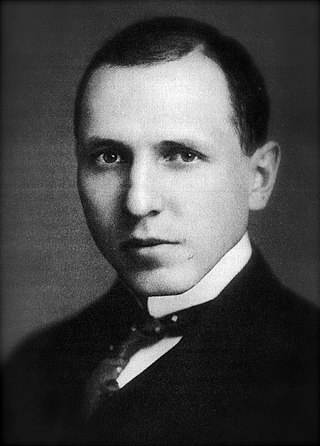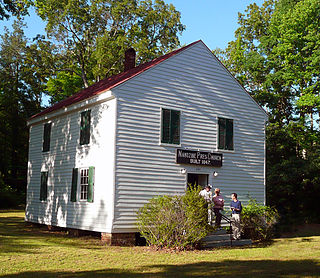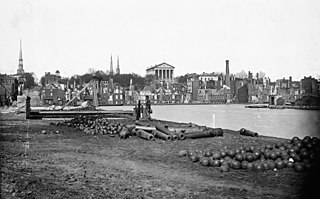
Robert Edward Lee was a Confederate general during the American Civil War, toward the end of which he was appointed the overall commander of the Confederate States Army. He led the Army of Northern Virginia—the Confederacy's most powerful army—from 1862 until its surrender in 1865, earning a reputation as a skilled tactician.

The Army of Northern Virginia, was the primary military force of the Confederate States of America in the Eastern Theater of the American Civil War. It was also the primary command structure of the Department of Northern Virginia. It was most often arrayed against the Union Army of the Potomac.

Ambrose Powell Hill Jr. was a Confederate general who was killed in the American Civil War. He is usually referred to as A. P. Hill to differentiate him from Confederate general Daniel Harvey Hill, who was unrelated.

Joseph Eggleston Johnston was an American career army officer, serving with distinction in the United States Army during the Mexican–American War (1846–1848) and the Seminole Wars. After Virginia declared secession from the United States, he entered the Confederate States Army as one of its most senior general officers. From 1888 to 1889 he was a vice president, from 1889 to 1890 president, of the Aztec Club of 1847.

Richard Stoddert Ewell was a career United States Army officer and a Confederate general during the American Civil War. He achieved fame as a senior commander under Stonewall Jackson and Robert E. Lee and fought effectively through much of the war. Still, his legacy was clouded by controversies over his actions at the Battle of Gettysburg and the Battle of Spotsylvania Court House.

George Washington Custis Lee, also known as Custis Lee, was the eldest son of Robert E. Lee and Mary Anna Custis Lee. His grandfather George Washington Custis was the step-grandson and adopted son of George Washington and grandson of Martha Custis Washington. He served as a Confederate general in the American Civil War, primarily as an aide-de-camp to President Jefferson Davis, and succeeded his father as president of Washington and Lee University in Lexington, Virginia.

Douglas Southall Freeman was an American historian, biographer, newspaper editor, radio commentator, and author. He is best known for his multi-volume biographies of Robert E. Lee and George Washington, for both of which he was awarded Pulitzer Prizes.

The American Civil War Museum is a multi-site museum in the Greater Richmond Region of central Virginia, dedicated to the history of the American Civil War. The museum operates three sites: The White House of the Confederacy, American Civil War Museum at Historic Tredegar in Richmond, and American Civil War Museum at Appomattox. It maintains a comprehensive collection of artifacts, manuscripts, Confederate books and pamphlets, and photographs.

William Henry Fitzhugh Lee, known as Rooney Lee or W. H. F. Lee, was the second son of General Robert E. Lee and Mary Anna Custis. He was a planter, a Confederate cavalry General in the American Civil War, and later a Democratic Congressman from Virginia.

Fitzhugh Lee was a Confederate cavalry general in the American Civil War, the 40th Governor of Virginia, diplomat, and United States Army general in the Spanish–American War. He was the son of Sydney Smith Lee, a captain in the Confederate States Navy, and the nephew of Robert E. Lee.

Samuel Cooper was a career United States Army staff officer, serving during the Second Seminole War and the Mexican–American War. Although little-known today, Cooper was technically the highest-ranking general officer in the Confederate States Army throughout the American Civil War, even outranking Robert E. Lee. After the conflict, Cooper remained in Virginia as a farmer.

The Battle of Namozine Church was an engagement in Amelia County, Virginia, between Union Army and Confederate States Army forces that occurred on April 3, 1865, during the Appomattox Campaign of the American Civil War. The battle was the first engagement between units of General Robert E. Lee's Confederate Army of Northern Virginia after that army's evacuation of Petersburg and Richmond, Virginia, on April 2, 1865, and units of the Union Army under the immediate command of Maj. Gen. Philip Sheridan, who was still acting independently as commander of the Army of the Shenandoah, and under the overall direction of Union General-in-Chief Lt. Gen. Ulysses S. Grant. The forces immediately engaged in the battle were brigades of the cavalry division of Union Brig. Gen. and Brevet Maj. Gen. George Armstrong Custer, especially the brigade of Colonel and Brevet Brig. Gen. William Wells, and the Confederate rear guard cavalry brigades of Brig. Gen. William P. Roberts and Brig. Gen. Rufus Barringer and later in the engagement, Confederate infantry from the division of Maj. Gen. Bushrod Johnson.

Gustavus Woodson Smith, more commonly known as G.W. Smith, was a career United States Army officer who fought in the Mexican–American War, a civil engineer, and a major general in the Confederate States Army during the American Civil War. He briefly commanded the Army of Northern Virginia from May 31 until June 1, 1862, following the wounding of General Joseph E. Johnston at the Battle of Seven Pines, and before General Robert E. Lee took command. Smith later served as an interim Confederate States Secretary of War and in the Georgia Militia.

William Ransom Johnson Pegram, known as "Willie" or "Willy", was an artillery officer in Robert E. Lee's Confederate Army of Northern Virginia during the American Civil War. He was mortally wounded in the Battle of Five Forks. He was the younger brother of Confederate General John Pegram, who was also killed in action. His grandfather, John Pegram, was a major general during the War of 1812.

Richmond, Virginia served as the capital of the Confederate States of America during the American Civil War from May 8, 1861, hitherto the capital had been Montgomery, Alabama. Notwithstanding its political status, it was a vital source of weapons and supplies for the war effort, as well as the terminus of five railroads, and as such would have been defended by the Confederate States Army at all costs.

Edwin Gray Lee was an American soldier from Virginia and a Confederate brigadier general during the American Civil War. He was a member of the Lee family and first cousin once removed of Robert E. Lee.

Robert Hall Chilton was an officer in the U.S. Army and then a brigadier general in the Confederate States Army during the American Civil War. He served as chief of staff for the Army of Northern Virginia under Robert E. Lee for much of the war.

The Robert E. Lee Monument in Richmond, Virginia, was the first installation on Monument Avenue in 1890, and would ultimately be the last monument removed from the site. Before its removal on September 8, 2021, the monument honored Confederate Civil War General Robert E. Lee, depicted on a horse atop a large marble base that stood over 60 feet (18 m) tall. Constructed in France and shipped to Virginia, it remained the largest installation on Monument Avenue for over a century; it was first listed on the National Register of Historic Places in 2007 and the Virginia Landmarks Register in 2006.
The Battle of Garnett's and Golding's Farms took place June 27–28, 1862, in Henrico County, Virginia, as part of the Seven Days Battles of the American Civil War's Peninsula Campaign. While the battle at Gaines's Mill raged north of the Chickahominy River, the forces of Confederate general John B. Magruder conducted a reconnaissance in force that developed into a minor attack against the Union line south of the river at Garnett's Farm. The Confederates attacked again near Golding's Farm on the morning of June 28 but in both cases were easily repulsed. The action at the Garnett and Golding farms accomplished little beyond convincing McClellan that he was being attacked from both sides of the Chickahominy.

The Stonewall Jackson Monument in Richmond, Virginia, was erected in honor of Thomas Jonathon "Stonewall" Jackson, a Confederate general. The monument was located at the centre of the crossing of Monument Avenue and North Arthur Ashe Boulevard, in Richmond, Virginia. The bronze equestrian statue was unveiled in 1919. Along this avenue are other statues including Robert E. Lee, J. E. B. Stewart, Jefferson Davis, Matthew Maury and more recently Arthur Ashe. Thomas Jackson is best known as one of Robert E. Lee's most trusted commanders throughout the early period of the American Civil War between Southern Confederate states and Northern Union states. He rose to prominence after his vital role in the Confederate victory at the First Battle of Bull Run in July 1861, continuing to command troops until his untimely death on May 10, 1863, after falling fatally ill following the amputation of his wounded arm.


















